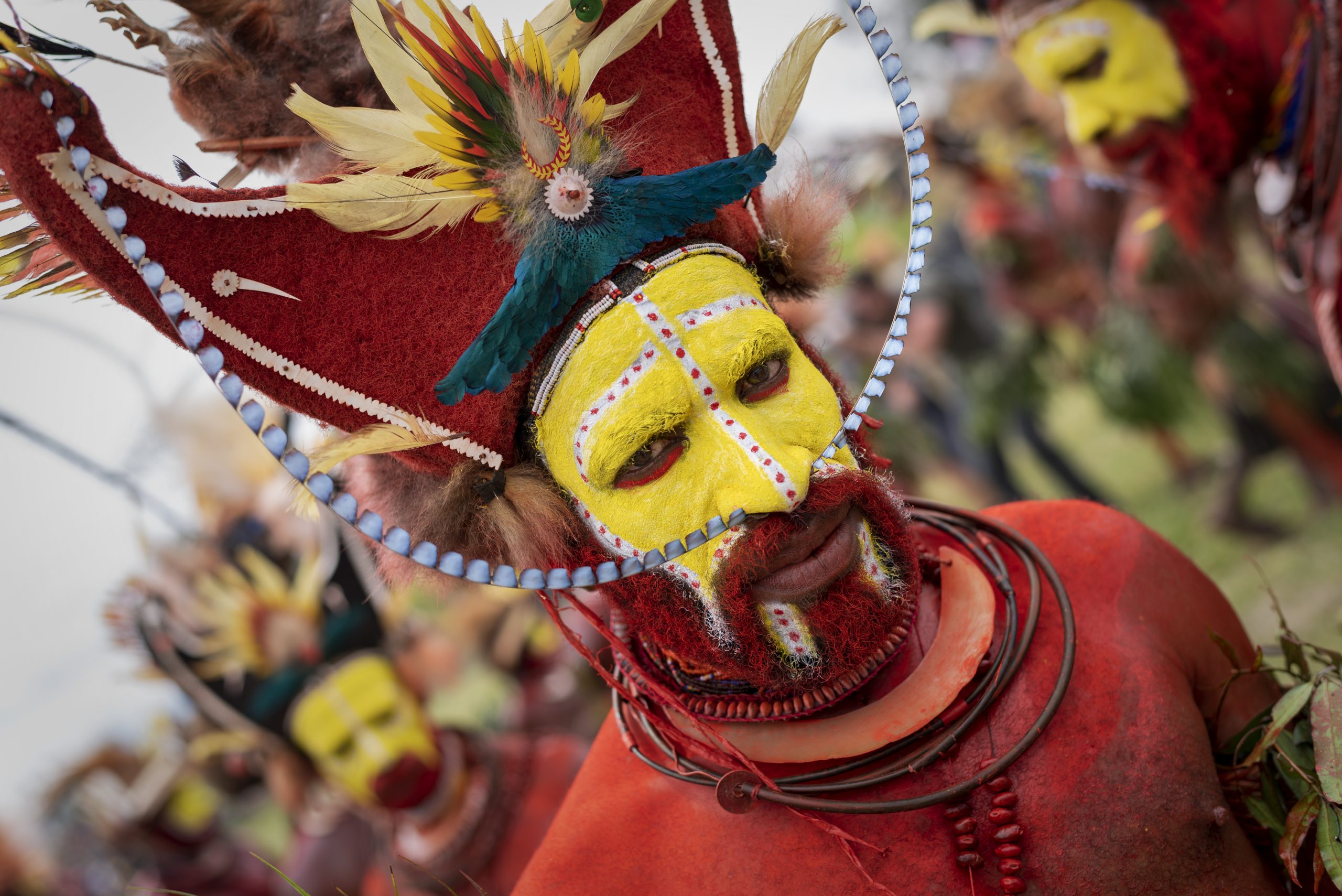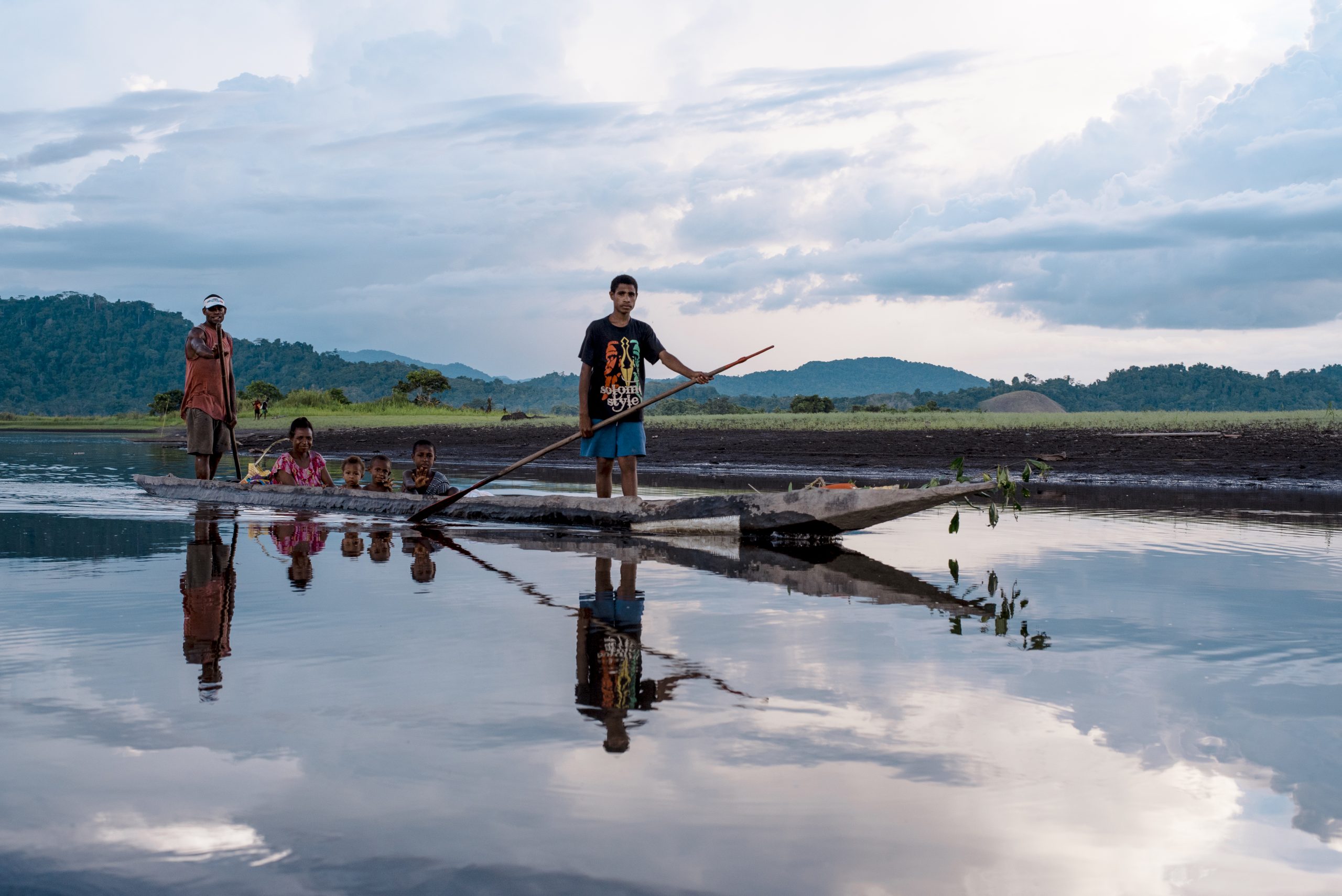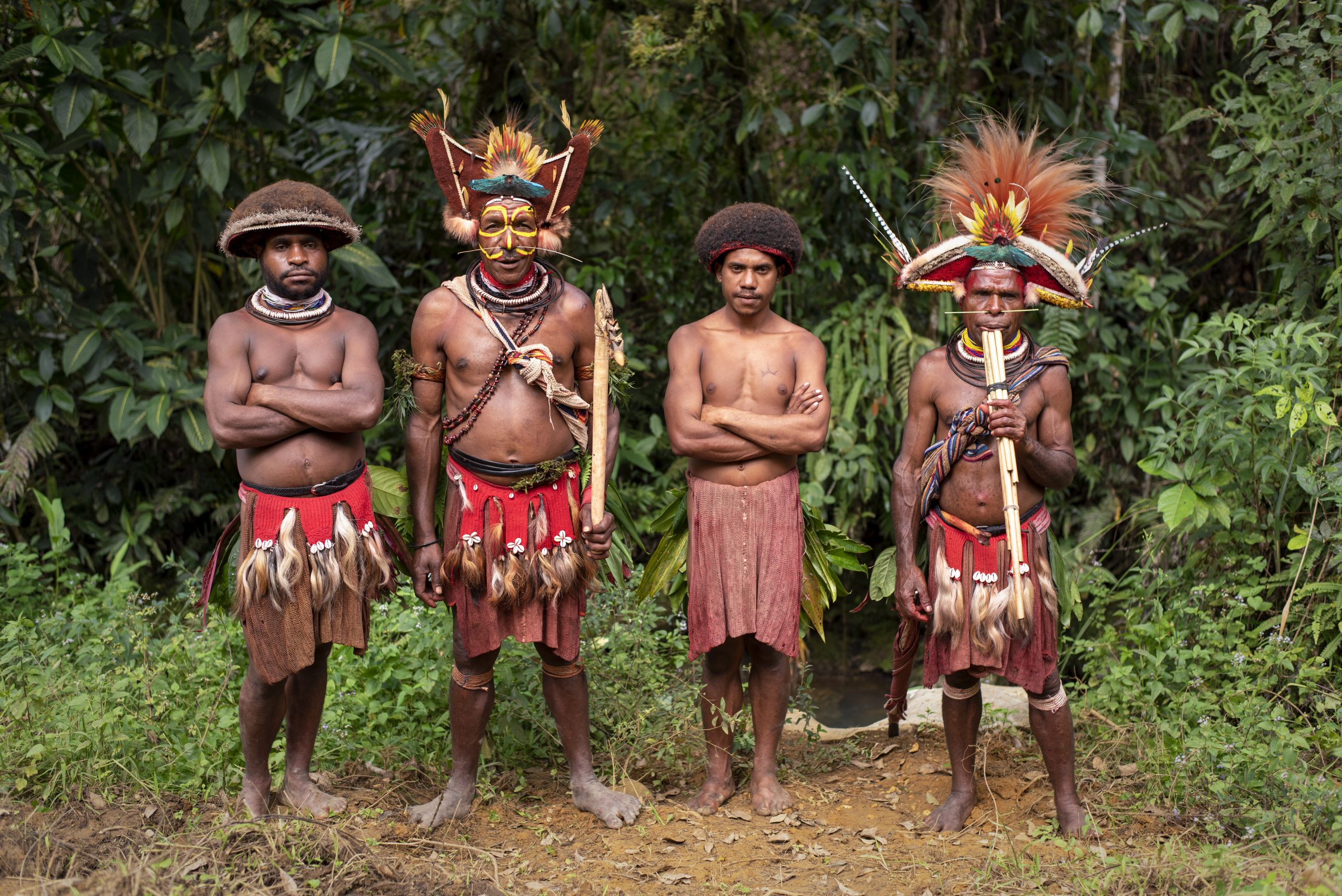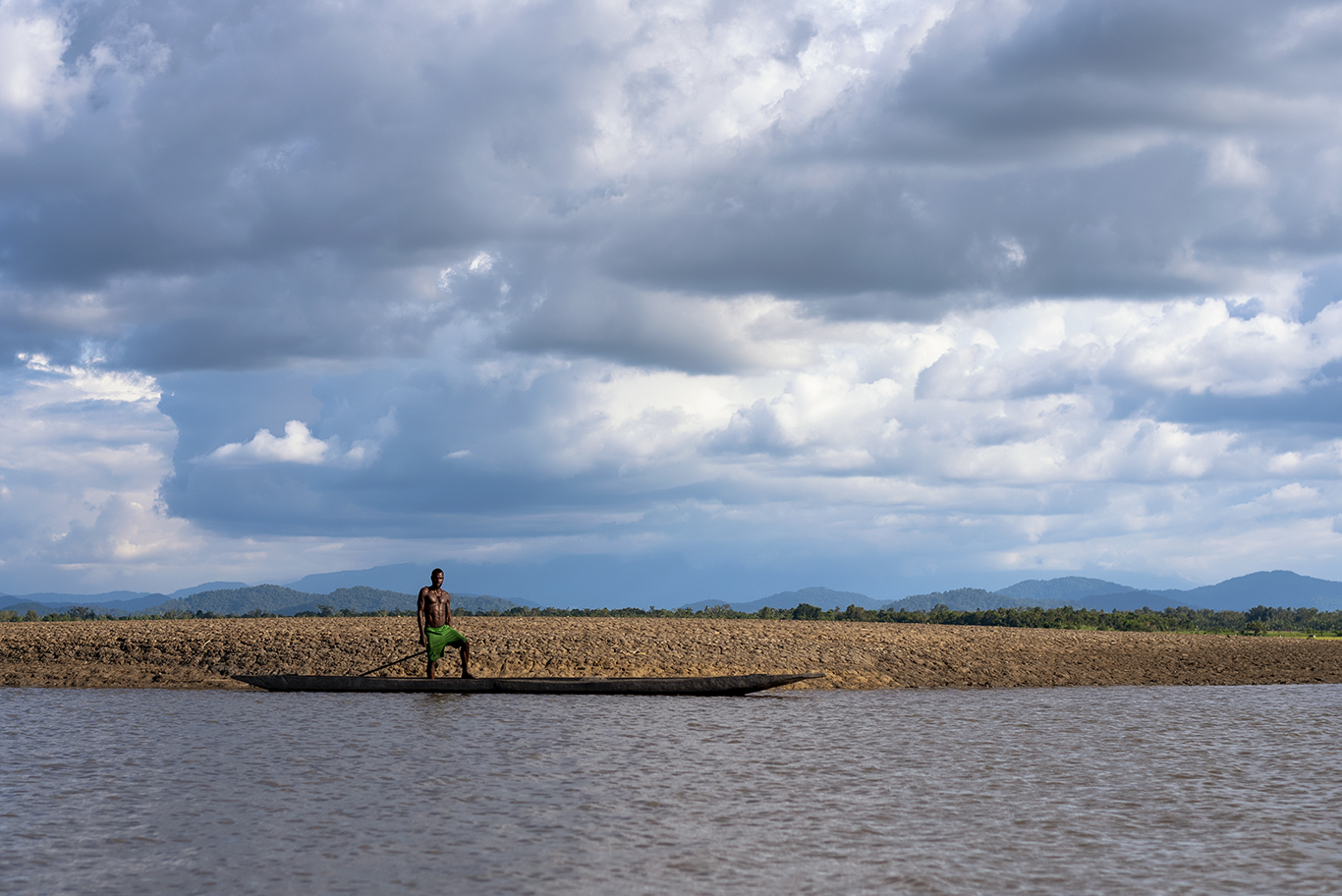
by mygrations | Sep 25, 2018
Those beautiful people, the cheerful colors, the great headdresses. More than 800 languages and as many different tribes, each with their own culture. The reason I have dreamed of going to Papua New Guinea for years.After staying with the Huli Wigmen for a week, it is now time to see some of those more than 800 tribes. And we do that during the Mount Hagen show; a show where tribes show their splendor in a sing-sing. By applying the most beautiful make-up, wearing the most fantastic headdresses and performing the most challenging dances. This seemed like a good idea instead of a fight, and I can’t disagree.
Because our car broke down for a while, we arrived a little later but just in time to see everyone getting ready for the big sing-sing. After the layout it was time to go to the field where it is all about to happen. And sometimes I can’t find words to describe what that was like, luckily I always know where to find my camera.
Below is a photo report of this fantastic day:


















Lees hier meer over mijn avonturen in Papoea Nieuw Guinea
Foto’s mogen niet zonder toestemming gebruikt worden.

by mygrations | Sep 10, 2018
Rightly so! It’s a dangerous country. If I have to believe the locals, thieves are everywhere. Especially in Port Moresby, Mount Hagen and the other major cities. Shutting windows and doors does not apply here in the event of a fire or flood, but in the case of a car stop. Especially in Mount Hagen, because the pickpockets will come to sniff in. (more…)

by mygrations | Sep 3, 2018
Thousands of crocodiles live in the Sepik River. We don’t see one. But that’s because they are scared, and that’s not surprising. They are hunted a lot.Many crocodile farms can be found along the Sepik. They remind me of mega stables in Europe. The booths are too small and animal welfare cannot be found there. Japanese and Chinese love these Sepik crocodiles. The hides are used to make shoes, coats and bags. The meat is consumed by the inhabitants of the village and tastes like chicken. Even though crocodiles eat fish here, not chicken.
More is not always better. An oversized crocodile cannot be sold. In that case, the crocodile is eaten by the villagers, beautiful chains are made of the teeth and the skin serves as decoration for the toilet, for example.
Thousands, “no millions” according to our guide Lesley, are there in the river, but after not having seen one on the river for 4 whole days, I start to doubt these numbers.

Kamanibit
Eat fish and sago
In Kamanibit, the village where we spend the night, we receive a necklace with a crocodile tooth as a souvenir. I think it’s cool but I wear it with mixed feelings. Yes, I am a carnivore but I am not in favor of mega stables and also not of animals as decoration. But I can’t refuse the crocodile tooth, it’s a gift. And fair is fair but it is no different than a nice piece of meat on your plate, right?
Crocodiles are hunted and fish are caught. We see dozens of women and children in boats that frequently bring in fish. Our skipper Pieter knows how to tell hundreds a day. The fish vary in size but they all actually taste the same. That will be because of the cooking arts; the fish is cooked on the fire and you remove the meat by hand. More often with than without bones. I wonder if this river will ever be emptied. After all, we are doing a good job overfishing the oceans so why should the Sepik lag behind? At the moment because they do everything here by hand, no trawl nets and bycatch, just like the fish, is cooked on the fire and eaten.
Fish and sago are the daily fare here. Sago comes from the sago palm, it is mixed with water before being cooked on fire. Then it is kept in a sago tray for a month before it can be eaten. It looks like a kind of rubber pancake and doesn’t actually taste like anything. Here they eat it daily, because they don’t have anything else (except fish and some fruit). Sometimes caterpillars are put in, for the protein and the flavor.

Mixing sago with water
Crocodile farm
Our last day on the water goes to Chambri lake. We have lunch at the village of Ibom. Our dry bread and peanut butter lunch is complemented with Pawpaw; a local fruit, orange on the inside, greenish on the outside. You take the seeds out with your hands and then you eat it like a melon. It also tastes a bit like it, more like Papaya by the way. But according to Lesley it is really different. I doubt it.
The village where we have lunch also has a small crocodile farm. That means: three very (read: way too) small cubicles where a lot of crocodiles are pressed together. They let them grow bigger here and then these skins are also sold to Japanese and / or Chinese. I think it looks horrible.

Besides breeding a few crocodiles, they also make pots here. With these pots they can cook inside instead of outside on a fire. They look nice but we decide not to buy one. Our gas burner in The Hague is still fine, besides it’s way too big to take with us.

Everything gets transported via water, including firewood.
The crocodile hunter
And then we move on. The village where we spend the night is called Palembei. We sleep with a real crocodile hunter. He also offers this as a tourist activity. You then go out with him at night to hunt crocodiles. Sometimes they bring in 8 in one night. If one is killed, they eat it. He locks up the living crocodiles.
According to him they are stupid animals. To catch 1 you throw a spear in its back, the crocodile wraps around it and you can grab it with your hands and throw it in a cage. I listen with interest but I also find it sad. If it was done to satisfy the hunger of the locals, okay. But to catch crocodiles because they want to walk with a nice bag in Japan, that is not possible with me. We therefore decline this tourist activity in a friendly manner.
We leave early the next day. At 6 o’clock, so it is still dark. Best chance of seeing crocodiles. And sure enough, one after another has emerged. Everywhere we see eyes light up when we shine on them. I don’t see them very well, but I’m glad to see that there are still a lot of them swimming around. Free, for however long.

by mygrations | Aug 30, 2018
I did not sleep well. The mattress should not bear the name. It’s so thin, with a hard wooden bed underneath that only allowed me to lie on my back. The pillow smells like the many people who used it for me and the beetles outside kept roaring. I also heard a lot of mice walking over our roof and Yuri had to go to the toilet several times. A typical night in Papua New Guinea.
So we are a bit tired when we are served delicious scrambled egg for breakfast. We arrived yesterday at Lukwanda lodge . It was dark and wet when we arrived. It is still wet now but oh how green it is here. And what birds I heard this morning. The lodge is very simple but it is fine. These days we will have to do with little because our luggage is still in London thanks to British Airways. Who then makes little effort to get our luggage here in Papua New Guinea. But we are now in Tari and the chance that the luggage will be brought here is nil.
We quickly throw in a cup of tea before we set off. We don’t really know where to go, but we do know that we are going to eat Mumu, a local delicacy. At least, we assume that.
Introduction to the mud trails
The trail to today’s village starts near the lodge. Because there is a war going on between two families, we cannot go too far into the wilderness because we may run into people we don’t want to meet. So we stay close to home, but even that makes for an adventure.
And that adventure begins with our introduction to the mud trails of Papua New Guinea. We slide down a kind of hill before balancing on a thin tree trunk over a large river. Then we climb a mud path to walk a bit through fields. We end at a cabin on a hill overlooking the Tari River. A large river where the water has risen considerably due to the amount of rain in recent days. We always bring rain with us, so that will probably not decrease in the coming days.
Actually, we were supposed to cross the river to eat Mumu in the village across the street. But due to the amount of water and the strong current in the river, we decide to make the Mumu at this house. Not a problem for us. It is fun and the owners of the piece of land take us around their land.
The family
The piece of land belongs to two brothers. Their father, who says he’s 120, is now enjoying his old age. There is no longer a mother. The two brothers are the owners, but the sisters, from another mother, are the ones who work the land. Along with a number of pigs. The sister, Ruth, who now works here shows us with hands and feet what she does. English is not spoken here, so we rely on sign language. And that’s fine. I understand that they grow sweet potato and broccoli, that the pigs are helping to turn the land, and that they are glad we are here.

Ruth, one of the sisters
After the small tour we go back to the house on the hill. Here we are going to make the Mumu. A typical dish from Papua New Guinea, and something they are very proud of. First they heat up stones on the fire. Then they dig a hole in the ground. In the meantime, a chicken is killed, vegetables and fruits are cut. Incidentally, I was not allowed to call it slaughter. That is so Western. Here in Papua New Guinea they just call it killing. And they are right.

Hugging a chicken that’s soon gonna be our meal.
The hole in the ground is first filled with the heated stones, on top of that are banana leaves in which the food is placed. The banana leaves are also put back on top to protect the food properly, followed by more warm stones. To close it well, the soil is shoveled on top of the stones. And so the food remains for more than 1.5 hours.

Picking chickens
Family quarrel in Papua New Guinea
With us a little longer because just after preparing the Mumu a small disagreement arose between the family members. At least it starts small, with some shouting and screaming. But soon, much to my delight, a machete is brought in. There are also sticks and the family members start to hit each other fairly hard. The machete is mainly used as a threat, but I still think it is dangerous. A number of times I am reassured with “don’t worry, family problems” and big smiles from everyone who does not belong to the family. Thomas tries to appease it several times, to no avail. I just keep a safe distance because even though they won’t attack me, the waving with the machetes doesn’t look very safe. After all, an accident can happen in a small corner.
They are an explosive people and that shows how this quarrel suddenly started. One moment we are all making Mumu and the next moment we are waving machetes. Of course this also concerns pieces of land. Some people have more than others and jealousy plays a big role.

And just as suddenly as it began, so suddenly it ends. The Mumu is ready and it is a shame to waste the vegetables and two chickens because of a pointless argument. So soon we are all enjoying the Mumu again. The banana that went in is very dry, the pawpaw (kind of papaya) is delicious, the sweet potato is also fantastic and I even enjoy eating the chicken.
The Huli Wigmen
After dinner it is time for the fortune teller. We are in the Huli Wigmen area. A tribe that I have wanted to see since 2005 when a colleague from MinBuZa went to Papua New Guinea. And now I am here and I have time to meet the Huli Wigmen. The Huli is the largest tribe in the country and is known for the wigs they make from their own hair. There are different wigs for different occasions.

A common wig takes about one year to make. It is the first wig that boys grow when they become men. For a year they sleep with a wooden block under their neck to shape the wig, they do this with a kind of wire. The wig as above is a special one, it takes about 2 to 3 years to make.
On special occasions they color their faces with bright yellow clay (this is called ambua) and are considered sacred. Their bodies make them ocher red. When they dance, during the sing-sing, they do a bird dance. Not to be confused with the terrible bird dance that we know in the Netherlands. With this bird dance they imitate the bird of paradise.

The Huli also do fortune counting. In this region there is one fortune teller left and we are going to meet him. His name is Erebo and he is dressed in his most beautiful Huli costume. Before we can enter the sanctuary, the forefathers must first be awakened. That happens in less than a minute.

Erebo
The fortune teller
We walk through a piece of woodland to finally arrive at a small clearing between all kinds of beautiful green trees and plants. In this clearing is a structure of wooden posts and planks on top of each other. I don’t know what it represents, but when we walk around it we suddenly see a number of yellow painted skulls in a row. Thomas knows how to tell us these are the ancestors. Nine generations of skulls lie ahead of us.
Erebo has now started the ceremony. It is a kind of song with words that cannot be understood. Thomas occasionally encourages him to continue singing. And when he stops, it’s time for Yuri to ask a question. He wants to know how the future of his love life is going. Erebo then asks the question to his forefathers. They don’t take long to answer; it stands in front of you 
Erebo makes it a bit more exciting and indicates that the person with whom Yuri grows old might be traveling with him. Maybe she’s here. What do you think?
We say goodbye to Erebo and return to the lodge. To rest because tomorrow we are going to make a long trek to a village somewhere in the middle of nowhere.





































